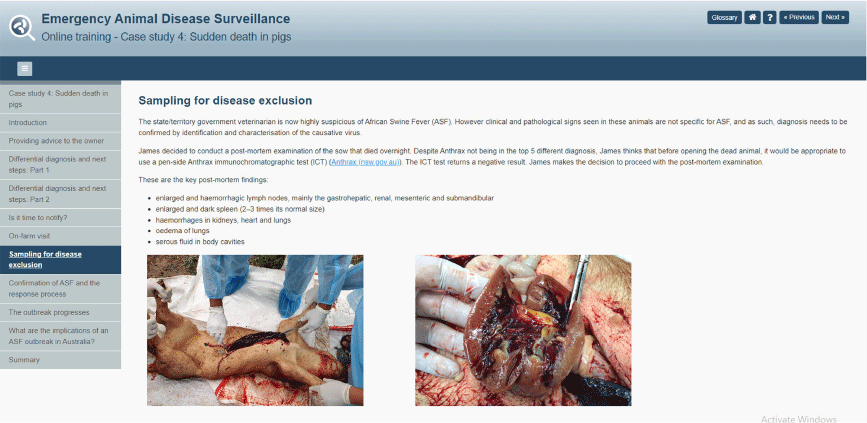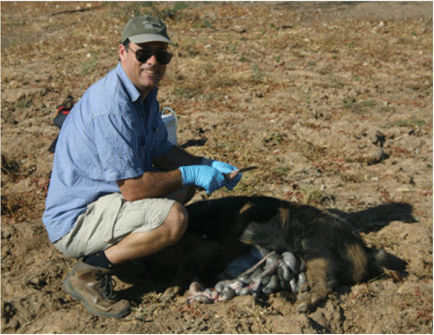The African swine fever threat to Australia
Michael P. Ward A *A Sydney School of Veterinary Science, The University of Sydney, Camden, NSW 2570, Australia.

Michael Ward is Chair, Veterinary Public Health and Food Safety in the Sydney School of Veterinary Science. He is a veterinary epidemiologist with experience in analytical epidemiological methods, spatial epidemiology and simulation modelling. He has more than 35 years’ experience in conducting research on infectious diseases. Michael is a veterinary graduate of the University of Queensland and has held positions within the Queensland Department of Primary Industries and the veterinary schools at Purdue University (Indiana) and Texas A&M University. He returned to Australia from Texas in 2008 to take up his current position at The University of Sydney. In 2010, Michael organised and hosted the GEOVET conference. He has acted as Associate Editor for the journals Preventive Veterinary Medicine and Zoonoses and Public Health. Michael is currently the Editor-in-Chief, Transboundary and Emerging Diseases. He currently leads the Local Organising Committee for the 17th International Symposium on Veterinary Epidemiology and Economics, planned for Sydney in 2024. |
Microbiology Australia 43(4) 183-185 https://doi.org/10.1071/MA22060
Submitted: 10 October 2022 Accepted: 18 November 2022 Published: 7 December 2022
© 2022 The Author(s) (or their employer(s)). Published by CSIRO Publishing on behalf of the ASM. This is an open access article distributed under the Creative Commons Attribution-NonCommercial-NoDerivatives 4.0 International License (CC BY-NC-ND)
Abstract
African swine fever (ASF) is not a new disease: its impact on domestic pig production in Africa was first documented 100 years ago. For most of the twentieth century ASF was considered a disease of Africa, with occasional incursions into Europe and the western hemisphere. However, during the past two decades, ASF has emerged as a truly global diseases, invading parts of Europe and spreading throughout Asia. By 2020, ASF had spread as far as Papua New Guinea. Why ASF has spread such distances so quickly is not well understood, however the movement of both live pigs and pork products undoubtedly is a major contributing factor. The role that wild pigs play in the spread and maintenance of ASF virus is a topic of ongoing debate. Adding to the complexity of the epidemiology of this disease, ASF virus can be transmitted by some tick species in particular ecosystems. Australia is vulnerable to an ASF virus incursion. The threat is further heightened by the uncertainty regarding whether our large and widely distributed feral pig population would become endemically infected, creating a barrier to eradication of the disease. Preventing an incursion of ASF virus relies on ongoing risk assessments based on where the virus currently exists, and the disease pathways for introduction. Within the Australian context, regulatory enforcement and surveillance of illegally important pork products is paramount to minimise the treat that ASF poses.
Keywords: African swine fever virus, biosecurity, epidemiology, pig, risk assessment, suid, surveillance, transboundary spread.
African swine fever (ASF) was first documented as a disease of domestic pigs in Africa 100 years ago.1 Despite some spread events outside of Africa – southern Europe in the 1950s and 1960s, and North and South America in the 1970s and 1980s – during the twentieth century ASF mostly was considered a disease affecting Africa, which involved a wild suid reservoir, tickborne spread, and high morbidity and mortality when the ASF virus (ASFV) spilled over to domestic pig populations. In most cases when ASFV spread outside of Africa, it was eradicated.
However, ASF has emerged and spread through much of the world during the first two decades of this century. A pivotal event was an ASFV incursion into the Republic of Georgia in 2007 and subsequent spread throughout parts of Eastern Europe and Russia, the Baltic and western Europe. ASFV also spread eastwards, entering China in 2018 and quickly spreading throughout east and south Asia. By early 2020 ASFV had reached Indonesia, Timor Leste and Papua New Guinea. Throughout Asia, ASFV appeared to spread in phases, as a propagating epidemic. Besides a clear hotspot developing in China, southeast Asia and in particular northern Vietnam, Laos and Cambodia have become hotspots of ASFV spread. Average mortality rates of about 25% were reported from this pandemic of ASF in Asia.2 Despite the devastating effect of ASF on pig production globally that has resulted in a serious risk to food security in places, ASF has been described as ‘The Forgotten Pandemic’.3 To date, a vaccine has not been successfully used to control this pandemic. Control options are limited to biosecurity measures.
ASFV has not been detected in Australian pigs, although virus fragments have been detected in food products that individuals have attempted to illegally import into Australia, and even in pork product for retail in Melbourne.4 ASFV has reached our doorstep, but what does the future hold?
Although ASFV is highly resistant in the environment, the transboundary spread of this virus has been linked more often to the trade in animal products. For example, the incursion in Brazil in 1978 was likely via food waste from transcontinental flights or animal products imported by tourists.5 Similar routes have been suspected in the incursion of ASFV into China and in the recent incursion in the Dominican Republic; spread within infected countries mostly seems to be via the movement of live pigs and pig products.6,7 The role that wild pigs play in ASFV spread is debatable. In Europe, wild boar (including hunting activities associated with this species) appear to play a role, albeit probably minor in most situations. In Asia the role of wild pigs at present is uncertain. Overall, the evidence that ASFV is transmitted between free-living and domestic pigs is limited.8 The evidence that is available is mostly relevant to the European situation.
To address this information gap, a review was recently conducted of the potential role that wild (including feral) pigs in Asia and the Pacific might play in ASFV spread.9 It involved a review of the current literature, analysis of the official reporting resources and a survey of the World Organisation of Animal Health Member delegates in Asia and the Pacific. Twelve species of endemic wild pig in Asia were documented – the abundant Sus Scrofa, seven other Sus spp. and three Babyrousa spp. (endemic to South-east Asia) and Porcula salvinia (endemic to North-East India). It was noted that these species make a substantial contribution to the diversity of Suidae species globally and are an important conservation resource. Except for Sus scrofa, all these endemic species appear to be declining in population distribution and abundance. Between July 2018 and June 2022 there were 2112 reports to the World Animal Health Information System (WAHIS) of ASF in wild pigs from four countries in the region: China (4), Laos (2), Malaysia (54) and the Republic of Korea (2052). This suggests that wild pigs are important in the spread and maintenance of ASFV in the Republic of Korea, whereas in other countries wild pigs are unlikely to play a role, or that infection within wild pig populations suffers from poor surveillance and is underreported. Feral pig populations might be an important risk factor – based on the Korean experience – but native species of wild pigs are not. Rather, ASFV might be a threat to these small populations of native pig species. In addition to WAHIS reporting, in this study member countries also reported ASF in wild pigs in Bhutan, India, Vietnam and The Philippines.
Risk assessments of ASFV incursions focus on pathways that include the movement of live pigs, pig products (mostly pork), movement of people, feed and wild pigs. In the case of the ASF threat to Australia, the introduction of this virus via live pigs – domestic or wild – appears unlikely because of Australia’s isolation and quarantine restrictions, in contrast to its spread throughout mainland Asia. And given the nature and distances involved in transportation, introduction via people as vectors and feed appears less likely. The greatest risk appears to be the illegal import of pork products. This is why a strong regulatory and surveillance system to control and monitor pig products imported into Australia is important. A program to test pork products seized at international airports and mail centres was initiated in 2018 by the Australian Government. During the period 2018–2019 there were a total of 853 samples tested, and 248 (29%) samples were found to contain ASFV fragments.10 Although this does not necessarily suggest that the material was contaminated with live virus, it does indicate that illegally imported food is a risk pathway. To put this in perspective, between 5 November 2018 and 31 October 2020 there was more than 43 tonnes of pork products carried by air travellers entering Australia that was intercepted.11 In addition, the final step in such a disease introduction pathway – exposure of domestic and wild pigs to contaminated food – is critical to control. For example, swill feeding is banned. Also, there are ongoing efforts to improve surveillance and reporting,11 as timely detection of an incursion is critical in eradicating the disease via a stamping out response. For example, an online training resource (Fig. 1) was recently released.12

|
The wild pig problem remains. Although in most situations wild pigs do not appear to play an important role in ASFV maintenance, Australia has a very large feral pig population and how ASFV might behave within our unique environment is unknown. Disease spread modelling based on field data collection (Fig. 2) has been undertaken on both classical swine disease and foot-and-mouth disease in northern Australia.13,14 Like ASF, both of these are serious transboundary animal diseases that currently do not exist in Australia. These studies suggest that feral pigs could be infected, which could create issues in disease eradication efforts and demonstration of freedom from disease. The control of feral pigs in Australia has not been highly successful. If feral pig populations become endemically infected with one or more of these transboundary diseases, then compartmentalisation (whereby domestic pig production can be considered separate from feral pig populations) would be highly challenging. The example of The Republic of Korea, where wild boar appear to be capable of maintaining the circulation of ASFV, is a situation well worth considering.

|
The Australian pig industry is worth about $5.3 billion annually, with 3400 production sites, and employs approximately 36 000 people.15 Considering how quickly ASFV has spread across Europe and Asia during the past two decades, its impact on pig production and its effect on trade, ASF is one of the most important disease threats currently facing Australia.
Data availability
Data sharing is not applicable as no new data were generated or analysed during this study.
Conflicts of interest
The authors declare no conflicts of interest.
Declaration of funding
This research did not receive any specific funding.
References
[1] Penrith, M-L et al.. (2021) One hundred years of African swine fever: a tribute to R. Eustace Montgomery. Transbound Emerg Dis 68, 2640–2642.| One hundred years of African swine fever: a tribute to R. Eustace Montgomery.Crossref | GoogleScholarGoogle Scholar |
[2] Mighell, E and Ward, MP (2021) African Swine Fever spread across Asia, 2018–2019. Transbound Emerg Dis 68, 2722–2732.
| African Swine Fever spread across Asia, 2018–2019.Crossref | GoogleScholarGoogle Scholar |
[3] Ward, MP et al.. (2021) African Swine Fever, the forgotten pandemic. Transbound Emerg Dis 68, 2637–2639.
| African Swine Fever, the forgotten pandemic.Crossref | GoogleScholarGoogle Scholar |
[4] Sullivan K (2022) Foot‐and‐mouth disease fragments detected in meat imported to Australia. 20 July. https://www.abc.net.au/news/2022-07-20/foot-and-mouth-disease-fragments-detected/101254410
[5] Lyra, TMP (2006) The eradication of African swine fever in Brazil, 1978–1984. Rev Sci Tech Off Int Epizoot 25, 93–103.
| The eradication of African swine fever in Brazil, 1978–1984.Crossref | GoogleScholarGoogle Scholar |
[6] Gonzales, W et al.. (2021) African swine fever in the Dominican Republic. Transbound Emerg Dis 68, 3018–3019.
| African swine fever in the Dominican Republic.Crossref | GoogleScholarGoogle Scholar |
[7] Cheng, J and Ward, MP (2022) Risk factors for the spread of African Swine Fever in China: a systematic review of Chinese-language literature. Transbound Emerg Dis 69, e1289–e1298.
| Risk factors for the spread of African Swine Fever in China: a systematic review of Chinese-language literature.Crossref | GoogleScholarGoogle Scholar |
[8] Brookes, VJ et al.. (2021) A scoping review of African swine fever virus spread between domestic and free-living pigs. Transbound Emerg Dis 68, 2643–2656.
| A scoping review of African swine fever virus spread between domestic and free-living pigs.Crossref | GoogleScholarGoogle Scholar |
[9] World Organisation for Animal Health (WOAH) (2022) African swine fever in wild pigs in the Asia and the Pacific Region. https://rr-asia.woah.org/wp-content/uploads/2022/09/woah_african-swine-fever-in-wild-pigs_final_23-sep-2022.pdf
[10] Department of Agriculture, Fisheries and Forestry (2021) Testing pork products seized at international airports and mail centres. https://www.agriculture.gov.au/biosecurity-trade/pests-diseases-weeds/animal/asf#testing-pork-products-seized-at-international-airports-and-mail-centres
[11] Animal Health Australia (2021) African swine fever. https://animalhealthaustralia.com.au/african-swine-fever/
[12] Emergency Animal Disease Surveillance (2022) Online training. Case study 4: sudden death in pigs. https://eadonline.com.au/modules/pigs/index.html
[13] Leslie, E et al.. (2014) Effective surveillance strategies following a potential Classical Swine Fever incursion in a remote wild pig population in north-western Australia. Transbound Emerg Dis 61, 432–442.
| Effective surveillance strategies following a potential Classical Swine Fever incursion in a remote wild pig population in north-western Australia.Crossref | GoogleScholarGoogle Scholar |
[14] Ward, M et al.. (2015) Modelling foot and mouth disease transmission in a wild pig–domestic cattle ecosystem. Aust Vet J 93, 4–12.
| Modelling foot and mouth disease transmission in a wild pig–domestic cattle ecosystem.Crossref | GoogleScholarGoogle Scholar |
[15] Australian Pork (2022) Industry facts. https://australianpork.com.au/industry-facts


